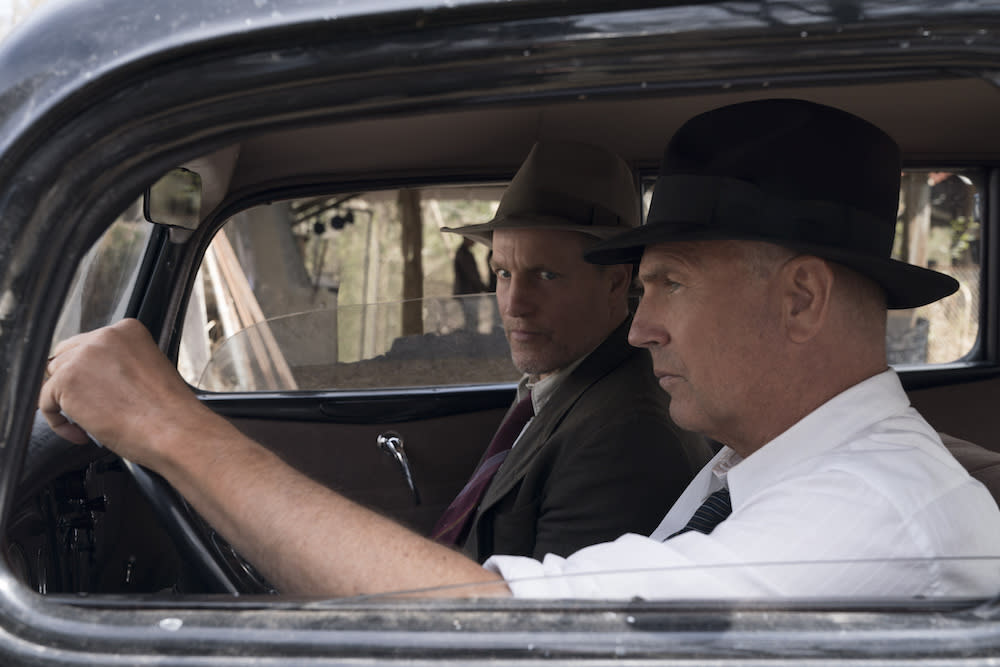SXSW Film Review: ‘The Highwaymen’

Arriving more than a half-century after Arthur Penn’s violent folk-ballad “Bonnie and Clyde” tapped into the zeitgeist and caught lightning in a bottle by portraying the Depression-era gangster couple in a manner that recast them as anti-establishment rebels, “The Highwaymen” aims to set the record straight with a respectfully celebratory depiction of the two lawmen most responsible for ending their bloody crime wave. Bosley Crowther, among others, likely would have approved of such revisionism. Still, this workman-like Netflix production — set to kick off a limited theatrical run March 15 before streaming March 29 — commands attention less as historical counterpoint than as a sturdy showcase for the neatly balanced lead performances of Kevin Costner and Woody Harrelson.
While Bonnie Parker and Clyde Parker are represented here more or less as fleetingly glimpsed abstractions, embodied by Emily Brobst and Edward Bossert in the manner of anonymous re-enactors in a cable-TV historical documentary, legendary Texas Ranger Frank Hamer and his redoubtable sidekick Maney Gault are vividly and approvingly depicted as aged but not obsolete old-school heroes who manfully rise to the occasion when younger, cockier, and better-equipped federal agents and state police officers prove unable to track down the trigger-happy criminals after Bonnie helps Clyde and an accomplice escape a Texas prison farm in 1934.
Related stories
SXSW Film Review: 'The Art of Self-Defense'
Kathy Bates, Kevin Costner Praise Theater Experience Amid Netflix Awards Debate (Watch)
Working from an efficiently straightforward screenplay by John Fusco (“Hildalgo”), “The Alamo” director John Lee Hancock uses brisk, broad brushstrokes during early scenes of exposition: Years after disbanding the Texas Rangers to make way for a new generation of law-enforcement personnel, Lone Star state governor Miriam “Ma” Ferguson (Kathy Bates), stung by bad publicity and angered by public adulation afforded Bonnie and Clyde, accepts advice from Texas Prison System chief Lee Simmons (John Carroll Lynch) to call Hamer out of retirement and give him “highwayman” status to ramrod his own manhunt. Hamer — who, truth to tell, doesn’t need much convincing to figuratively get back in the saddle, despite the concern of his supportive wife (Kim Dickens) — in turn enlists his old and fellow ex-Ranger Gault to join him on the hunt.
For long stretches thereafter, “The Highwaymen” relies almost entirely on the chemistry generated by Costner and Harrelson to sustain interest, as Hamer (memorably played as a far less complex character by Denver Pyle in Penn’s version) and Gault follow their guts and trust their instincts while methodically follow clues and connect dots overlooked by other lawmen using new-fangled crime-solving aids like wiretapping and aerial reconnaissance. Their approach is dogged, even plodding, but it’s obvious that they couldn’t work much faster if they tried: Each man is thick around the waist and easily winded during foot chases. (Gault needs to take frequent bathroom breaks, a running gag that somehow never gets tiresome.) And yet, not unlike John Wayne during his late-period films, both men can manhandle younger guys who need manhandling when the need arises. It’s just that, in their case, they have more frequent need to back up their fists with brandished weapons.
It’s not difficult to imagine an alternative version of “The Highwaymen” in which the concept of old-timers hunting bad guys is played for laughs (think “The Sunshine Boys” armed with tommy guns) and these same two lead players coasting through with easygoing aplomb. But Hancock takes his cue from the somber, almost elegiac tone of Fusco’s script — which reportedly was considered years ago as a vehicle for Paul Newman and Robert Redford.
As a result, Costner and Harrelson spend a good deal of time discussing the responsibilities that weigh heavily upon them as they continue their manhunt, and their differing yet ultimately complementary philosophies regarding violent responses to violent criminals. Costner is the more dour of the pair, though he is allowed more than his fair share of dryly humorous remarks, while Harrelson is freer to fling frequent wisecracks, and the mix is most entertaining. But each actor gets to deliver what are essentially dramatic soliloquies while describing mayhem that immutably shaped their characters. That might sound too corny by half, but Costner and Harrelson effectively infuse their words with world-weary conviction.
“The Highwaymen” boasts persuasive period detail across the board, yet features only a few scenes that can be described as conventionally exciting — and, of course, the climactic ambush of Bonnie and Clyde, almost as bloody as the one in Penn’s 1967 movie, is one of them. Arguably more impressive, however, is a high-speed car chase across dusty flatlands that ends with Hamer and Gault being outmaneuvered by their quarries. Gault is so embarrassed, he’s moved to question his and Hamer’s abilities. (“Maybe it ain’t in us no more.”) But Hamer remains resolved. He knows what they must do, even though neither he nor Gault take any apparent delight when the deed is done.
It should be noted, by the way, that “The Highwaymen” indicates the celebrity Bonnie and Clyde enjoyed during their brief lifetimes even more explicitly than Penn’s “Bonnie and Clyde” ever did. This is especially true during the film’s final moments, ending on exactly the right note for Hancock and Fusco’s take on the tale.
RELATED CONTENT:
Sign up for Variety’s Newsletter. For the latest news, follow us on Facebook, Twitter, and Instagram.

